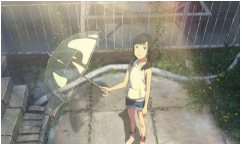
Submission to VIJ 2023-09-10
Copyright (c) 2023 Fairuz, Jehezkiel Jeven Efraim

This work is licensed under a Creative Commons Attribution 4.0 International License.
Abstract
Anime is one of the media for Japanese society to convey messages. The messages are in the form of cultural values and myths that develop and originate from traditional Japanese culture. Belief in myths continues to grow, even influencing Japanese culture, art and literature. One of the myths that is still believed by Japanese people is the existence of "kami" (gods). Most Japanese people adhere to the Shinto religion and believe in Kami. We are all things that smell sacred in the surrounding natural environment. One of the “kami” that the Japanese people believe in is the Fox God Inari. The Fox God Inari is the god of virtue and fertility. Japanese people also believe in Hare Onna. Hare Onna who has the power to change rainy weather to sunny and is the messenger of God Inari. The existence of this Hare Onna can be seen in the anime Tenki no Ko by Makoto Shinkai. This study aims to reveal how the actors of the story, and the setting represent the Hare Onna by using the analytical descriptive research method and Stuart Hall's representation theory. The results of the study show that the actors of the story and the setting of the story represent the strong desire of the Japanese people to turn bad weather into sunny so that their activities can run smoothly and bring prosperity to the surrounding environment through the presence of Hare Onna.
References
- Cohn, N. (2010). Japanese visual language: The structure of manga. Manga: An anthology of global and cultural perspectives, 187-203.
- Creswell, J. W. (2010). Research Design Pendekatan Kualitatif, Kuantitatif, dan Mixed. yogyakarta: pustaka pelajar.
- Darma, B. (2004). Pengantar Teori Sastra. Jakarta: Depdiknas, Pusat Bahasa.
- Djam’annuri. (1981). Agama Jepang. Yogyakarta: Pt Bagus Arafah.
- Ghazali, A. M. (2011). Antropologi Agama. Bandung: Alfabeta.
- Hall, S. (1997). Representation: Cultural Representations and Signifying Practices. London: Sage Publication
- Hodges, G. C. (2017). Reasons for reading: Why literature matters 1. In International Perspectives on the Teaching of Literature in Schools (pp. 175-193). Routledge.
- Moesono, A. (2003). Psikoanalisis dan Sastra . Depok: Moesono, Anggadewi. Pusat Penelitian Kemasyarakatan dan Budaya Lembaga Penelitian Universitas Indonesia. .
- Pratista, H. (2008). Memahami Film. Yogyakarta: Homerian Pustaka.
- Fairuz, Rahman, F., Nurhayati, & Amin, M. A. (2022). Authors’ Figurative Expressions From Two Novels: A Comparative Analysis Between RTJNA Rosso and RTJNA Blu. Theory and Practice in Language Studies, 12(1), 150-157.
- Rahman, F. (2018). The Constraints of Foreign Learners in Reading English Literary Works: A Case Study at Hasanuddin University. Journal of Arts and Humanities, 7(2), 01-12.
- Rahman, F., & Weda, S. (2018). Students’ perceptions in appreciating English literary works through critical comment: A case study at Hasanuddin University and Universitas Negeri Makassar. Asian EFL Journal, 20(3), 149-172.
- Shirane, H. (2012). Traditional Japanese literature: An anthology, beginnings to 1600. Columbia University Press.
- Sosrohadi, S., & Wulandari, D. (2022). Character Discrimination Analysis in the Novel Maryam by Okky Madasari. ELS Journal on Interdisciplinary Studies in Humanities, 5(2), 187-197.
- Totman, C. (2014). A history of Japan. John Wiley & Sons.